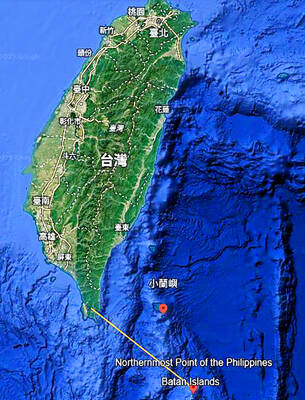Iran said it completed two days of missile tests that included launching its longest-range missiles yesterday, weapons capable of carrying a warhead and striking Israel, US military bases in the Middle East and parts of Europe.
State TV said the powerful Iranian Revolutionary Guards Corps (IRGC), which controls Iran’s missile program, tested upgraded versions of the medium-range Shahab-3 and Sajjil missiles, which have a range of up to 2,000km. It was the third and final round of missile tests in two days of drills by the IRGC.
The Sajjil-2 missile is Iran’s most advanced two-stage surface-to-surface missile and is powered entirely by solid-fuel, while the older Shahab-3 uses a combination of solid and liquid fuel in its most advanced form, which is also known as the Qadr-F1.
Solid fuel is seen as a technological breakthrough for any missile program as it increases the accuracy of missiles in reaching targets.
The war games come at a time when Iran is under intense international pressure to fully disclose its nuclear activities.
They began on Sunday, two days after the US and its allies disclosed that Iran had been secretly developing an underground uranium enrichment facility and warned the country it must open the site to international inspection or face harsher international sanctions.
General Hossein Salami, head of the IRGC Air Force, said on Sunday the drills were meant to show Tehran is prepared to crush any military threat from another country.
Meanwhile, Iranian Defence Minister Ahmad Vahidi warned Israel yesterday against launching any attack on the Islamic Republic, saying it would only speed up the Jewish state’s own demise.
“If this happens, which of course we do not foresee, its ultimate result would be that it expedites the Zionist regime’s last breath,” Vahidi said on state television.
Israeli leaders have repeatedly expressed alarm over Iran’s nuclear ambitions and refused to rule out pre-emptive military action to stop Iran developing an atomic weapon.
Iran, which says its nuclear work is for peaceful power generation, has often shrugged off the possibility of any such strikes.
Vahidi, a former IRGC commander, said that in the event of an Israeli attack, its “lifespan, which is today coming to an end, would be speeded up.”
He said that the “Zionist regime,” the term Iran uses for Israel, was on a “slope of destruction.”
On Saturday, Israeli Foreign Minister Avigdor Lieberman said a newly disclosed nuclear facility in Iran was proof the Islamic Republic was seeking nuclear weapons and called on the world to make an “unequivocal” response.
Israel, widely assumed to be the Middle East’s sole nuclear power, has described Iran’s uranium enrichment as a threat to its existence. It says “all options” are on the table in preventing Tehran from building nuclear missiles.
British Prime Minister Gordon Brown’s spokesman said yesterday that Iran’s missile tests were “a matter of concern,” but added that London’s focus remained on Tehran’s atomic program.

SECURITY: As China is ‘reshaping’ Hong Kong’s population, Taiwan must raise the eligibility threshold for applications from Hong Kongers, Chiu Chui-cheng said When Hong Kong and Macau citizens apply for residency in Taiwan, it would be under a new category that includes a “national security observation period,” Mainland Affairs Council (MAC) Minister Chiu Chui-cheng (邱垂正) said yesterday. President William Lai (賴清德) on March 13 announced 17 strategies to counter China’s aggression toward Taiwan, including incorporating national security considerations into the review process for residency applications from Hong Kong and Macau citizens. The situation in Hong Kong is constantly changing, Chiu said to media yesterday on the sidelines of the Taipei Technology Run hosted by the Taipei Neihu Technology Park Development Association. With

A US Marine Corps regiment equipped with Naval Strike Missiles (NSM) is set to participate in the upcoming Balikatan 25 exercise in the Luzon Strait, marking the system’s first-ever deployment in the Philippines. US and Philippine officials have separately confirmed that the Navy Marine Expeditionary Ship Interdiction System (NMESIS) — the mobile launch platform for the Naval Strike Missile — would take part in the joint exercise. The missiles are being deployed to “a strategic first island chain chokepoint” in the waters between Taiwan proper and the Philippines, US-based Naval News reported. “The Luzon Strait and Bashi Channel represent a critical access

‘FORM OF PROTEST’: The German Institute Taipei said it was ‘shocked’ to see Nazi symbolism used in connection with political aims as it condemned the incident Sung Chien-liang (宋建樑), who led efforts to recall Democratic Progressive Party (DPP) Legislator Lee Kun-cheng (李坤城), was released on bail of NT$80,000 yesterday amid an outcry over a Nazi armband he wore to questioning the night before. Sung arrived at the New Taipei City District Prosecutors’ Office for questioning in a recall petition forgery case on Tuesday night wearing a red armband bearing a swastika, carrying a copy of Adolf Hitler’s Mein Kampf and giving a Nazi salute. Sung left the building at 1:15am without the armband and apparently covering the book with a coat. This is a serious international scandal and Chinese

COUNTERINTELLIGENCE TRAINING: The ministry said 87.5 percent of the apprehended Chinese agents were reported by service members they tried to lure into becoming spies Taiwanese organized crime, illegal money lenders, temples and civic groups are complicit in Beijing’s infiltration of the armed forces, the Ministry of National Defense (MND) said in a report yesterday. Retired service members who had been turned to Beijing’s cause mainly relied on those channels to infiltrate the Taiwanese military, according to the report to be submitted to lawmakers ahead of tomorrow’s hearing on Chinese espionage in the military. Chinese intelligence typically used blackmail, Internet-based communications, bribery or debts to loan sharks to leverage active service personnel to do its bidding, it said. China’s main goals are to collect intelligence, and develop a